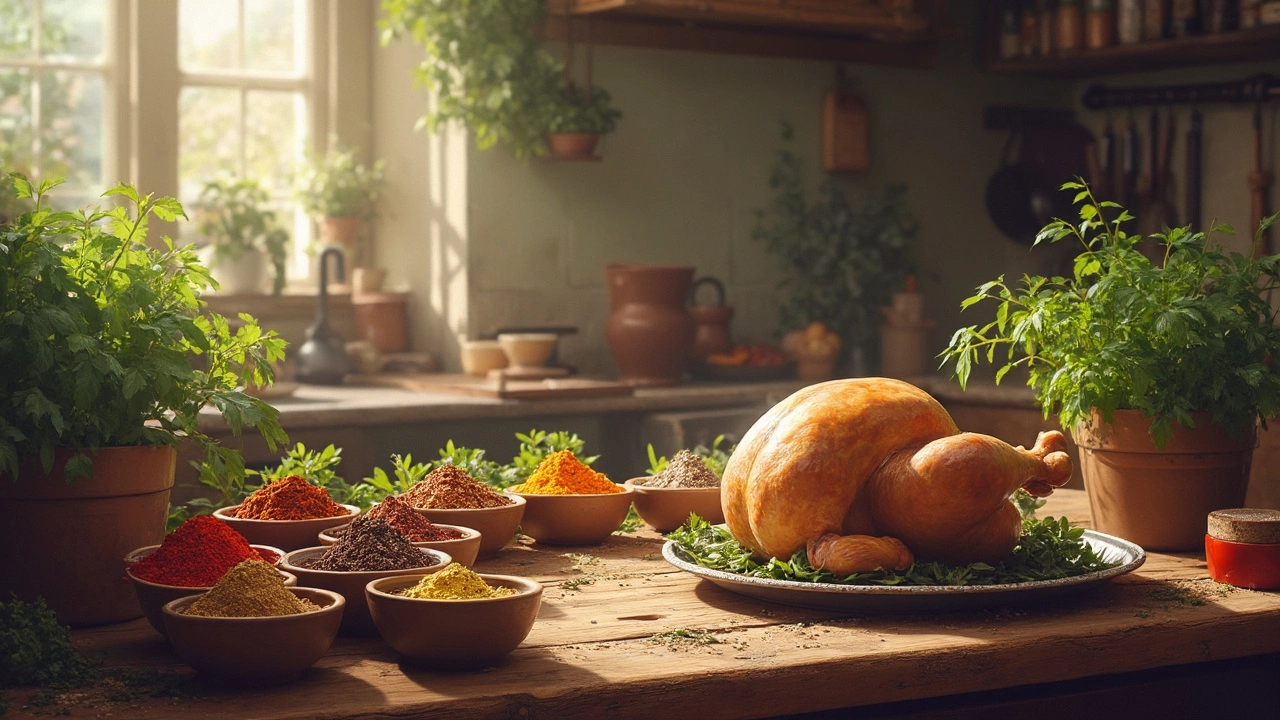Ever thought about what makes chicken taste amazing? It often boils down to more than just the recipe. The quality of chicken, the marinade you use, and even how it’s cooked can make all the difference. Let’s start with choosing the right chicken. Opt for organic or free-range chickens if you can—they often have a richer flavor.
Next, let’s talk marinades and seasonings. They’re key players in the taste game. A simple mix of olive oil, lemon, garlic, and herbs can do wonders. Don’t forget to let the chicken soak in those flavors for a good few hours, or even overnight if you can.
When it comes to cooking methods, roasting and grilling are top-notch. They lock in juices and bring out the chicken’s natural flavor. Make sure you’re cooking at the right temperature to avoid dryness.
- Choosing the Right Chicken
- Marinades and Seasonings
- Cooking Techniques
- Fresh Herbs and Ingredients
- Cultural Twists on Chicken
- Troubleshooting Common Flavors
Choosing the Right Chicken
Picking the right chicken is the first step towards creating the best tasting chicken dishes. Not all chickens are the same, and your choice can really swing the flavor pendulum.
Types of Chicken
The type of chicken you choose plays a big role. Organic or free-range chickens tend to have a deeper taste due to their diet and living conditions. While they might cost a tad more, the investment in flavor is often worth it.
Another option is the corn-fed chicken, which is known for a slightly sweeter and richer flavor. It's also generally more tender.
Freshness Matters
Buying fresh chicken can’t be stressed enough. Fresh chicken not only tastes better but it also cooks more evenly. While shopping, check for a pinkish hue without greyish tones, and it shouldn't have any strong odor. If it smells “off,” it probably is.
Consider the Cuts
Your choice of cut matters based on what you're cooking. For juicy, flavorful chicken recipes, thighs and drumsticks are your go-to due to their higher fat content. For cleaner, healthier options, breasts and tenders are preferred, though they require diligent cooking to avoid dryness.
Comparing Nutritional Value
Here's a quick comparison of different chicken options you might consider:
| Chicken Type | Calories | Protein | Fat |
|---|---|---|---|
| Organic | 165 | 31g | 3.6g |
| Free-range | 170 | 28g | 6g |
| Corn-fed | 175 | 27g | 7g |
These are average values for 100g servings, and they provide a great insight into what you're consuming. As a rule of thumb, balancing flavor with nutritional needs helps in making the right choice.
Ultimately, understanding your preferences and what you're aiming for in your dish will guide your chicken choices and make your meals shine.
Marinades and Seasonings
So you want to amp up your chicken's flavor? You'll need to master the age-old art of marinades and seasonings. It's no secret that these can make or break your dish. A good marinade doesn't just add flavor, it also tenderizes the meat, which is especially handy for tougher cuts.
Basic Marinade Building Blocks
Think of a marinade as a formula: acid, fat, seasoning, and extras. Start with a basic acid like lemon juice, vinegar, or yogurt. These break down proteins and help infuse flavors. For fat, olive oil is a classic choice—it helps coat the chicken and hold the marinade on the surface.
Essential Seasonings
No marinade is complete without the right seasonings. Salt and pepper are your foundation, but feel free to explore. Herbs like thyme, oregano, and rosemary compliment chicken beautifully. Don’t shy away from garlic, ginger, and onion—they add depth and complexity to your chicken recipes.
- Italian marinade: Combine olive oil, lemon, garlic, basil, oregano, and a pinch of salt. Perfect for grilling.
- Asian flair: Mix soy sauce, ginger, sesame oil, and honey. Try it with wings!
- Mediterranean touch: Use olive oil, lemon juice, rosemary, and a dash of paprika. Great for a summer barbecue.
Timing is Everything
Letting your chicken sit in the marinade is crucial. Ideally, you'll want to let the chicken soak for a minimum of two hours. Overnight is even better if you're planning ahead. This gives the chicken time to absorb all those tasty flavors.
If you're keen on trying different seasonings, here’s a handy guide on when to go light or heavy with them:
| Type of Chicken | Marinade Time | Best Bold Flavor |
|---|---|---|
| Breast | 2-4 hours | Citrus-based |
| Thighs | 4-8 hours | Herb-rich |
| Whole Chicken | 12-24 hours | Spice-heavy |
So there you have it. With these simple yet effective tips, you can transform any chicken dish from bland to brilliant. Good marinades and seasonings aren't just about following recipes—it's about creating flavors that work for you. Happy cooking!
Cooking Techniques
Alright, let's unravel some of the best cooking techniques that can make your chicken not just tasty but unforgettable. First things first, having a go-to method can be a lifesaver, whether it's roasting thoroughly or perfectly grilling.
Roasting
Roasting is a classic technique known for enhancing the taste. Preheat your oven to around 200°C (390°F). Place the chicken in a roasting pan, ideally on a bed of vegetables like carrots and onions that can absorb the juices. This prevents the chicken from sitting in its own juice and steams it instead. A nice tip: Check your chicken's internal temp—you're aiming for about 75°C (165°F) in the thickest part.
As Julia Child once said,
“You don't have to cook fancy or complicated masterpieces—just good food from fresh ingredients.”
Grilling
This method is for when you're feeling a bit adventurous. Grilling imbues a smoky flavor that's hard to beat. Start with a clean grill, preheat it, and brush a bit of oil on the grates to prevent sticking. Cook the chicken over medium heat—about 10–12 minutes each side depending on size. Remember, don’t press down on the meat; it lets the juices escape.
Stir-frying
When you’re short on time, stir-frying is your friend. Using a hot pan, add a splash of oil, and quickly toss bite-sized chicken pieces. It seals in the flavor and keeps the chicken juicy. Add some veggies and a dash of soy sauce for an Asian twist.
Simmering
For dishes needing tenderness, like stews, simmering works wonders. Use a hearty stock or broth, let the chicken pieces simmer gently on low heat. This keeps them moist and full of flavor.
Best Tasting Chicken can come from mastering these techniques. Don’t shy away from trying them out—this is how you develop your own signature chicken dish.

Fresh Herbs and Ingredients
Using fresh herbs and ingredients is like inviting flavor to a party in your kitchen. They can take your chicken from bland to mouth-watering. Whether you're grilling, roasting, or frying, consider adding a mix of herbs to add depth and complexity to your dish.
Let's break it down. Basil, cilantro, and parsley are some of the go-to herbs most people love to use with chicken. Their fresh, vibrant flavors can brighten up any recipe. Plus, these herbs are pretty easy to find in any grocery store or market.
Why Choose Fresh Over Dried?
Sure, dried herbs can be convenient, but fresh herbs pack a punch. They release essential oils and offer a brighter, more aromatic experience. An interesting tip: you often need about three times as much fresh herb as the dried version to hit the same level of flavor intensity.
Adding Vegetables
If you’re packing your chicken dishes with veggies, go with fresh onions, bell peppers, and maybe some cherry tomatoes. Not only do they add texture, but they also bring natural sweetness and extra nutrients. Now, who wouldn’t want a meal that’s both delicious and nutritious?
The Perfect Combos
Try pairing chicken with a simple combo of lemon, thyme, and rosemary. Trust me, it's classic for a reason! Or, if you're feeling adventurous, go for a mix of chili, lime, and cilantro for something with a kick.
And hey, remember to store your fresh herbs properly. Keep them in the fridge wrapped in a damp paper towel or in a glass of water like a bouquet. That way, they'll last longer and keep your dishes tasting their best.
Cultural Twists on Chicken
Every culture seems to have its own spin when it comes to cooking chicken, and why not? The humble bird is like a blank canvas, perfect for embracing various flavors and cooking styles from around the world. Let’s take a tasty trip and explore how different cuisines have transformed chicken into beloved dishes.
Asian-Inspired Chicken Dishes
In Asia, chicken recipes often rely heavily on bold seasonings. Think about soy sauce, sesame oil, and ginger mingling together in a stir-fry. Or the deep, flavorful punch of Szechuan peppercorns in spicy Szechuan chicken. Ever tried Korean fried chicken? It’s double-fried for an extra crispy skin, then doused with sweet and spicy sauce. Delicious!
Middle Eastern & Mediterranean Flair
Traveling west, we stumble upon a delightful Middle Eastern dish called shawarma. Here, the chicken is marinated in a mix of spices like cumin, paprika, and garlic, then cooked on a rotisserie until it’s tender and full of flavor. Mediterranean cuisines, particularly Greek, love using lemon juice and oregano to marinate chicken, often grilled and served with a side of tzatziki.
European Comforts with Chicken
Over to Europe, where you’ll find rich, creamy recipes. Take the French dish Coq au Vin – chicken slow-cooked with wine, mushrooms, and onions, creating a deep, savory flavor. In Italy, Pollo alla Cacciatora, translates to ‘hunter’s chicken’ and it’s simmered in tomatoes, garlic, and wine.
Americas: Bold and Smoked
In the Americas, barbecued chicken is king. Whether it’s the smoky, tender pieces from the southern United States or spicy jerk chicken from Jamaica, the emphasis is on bold flavors and outdoor cooking. BBQ sauce or spicy rubs play a huge role, giving the chicken unique characteristics.
Whichever cuisine you gravitate towards, the beauty of chicken lies in its versatility. Experimenting with these cultural twists can elevate your cooking game and introduce you to delightful new flavors. So next time, try taking the road less traveled in your kitchen and give your regular recipes a global makeover!
Troubleshooting Common Flavors
Sometimes your best tasting chicken might not hit the mark. Let's tackle some common issues and get it right next time.
Bland-tasting Chicken
Ever cooked chicken, only to find it tastes like nothing? That's due to insufficient seasoning or marinating. Next time, make sure to season your chicken generously with salt, pepper, and your choice of herbs and spices. Give the marinade more time—overnight works wonders.
Overly Salty Chicken
This usually happens when using too much soy sauce or table salt. If the chicken is too salty, try balancing it out by adding a sweet component like honey or brown sugar in your future marinades.
Dry Chicken
Nobody likes dry chicken! It happens when it’s overcooked. Use a meat thermometer to check the internal temp; aim for 75°C (165°F). Also, try cooking chicken with the skin on—it keeps the moisture locked in and enhances the chicken flavor.
Overpowered by One Spice
If a single spice seems to hit you like a truck, reduce it in your mix. Balance is key; it's better to add spices gradually and taste along the way than to try to salvage a spice explosion.
| Issue | Solution |
|---|---|
| Bland | More seasoning and longer marinating |
| Salty | Add something sweet |
| Dry | Check internal temp; use skin-on |
| Overpowered | Use spices sparingly and taste |
Remember, cooking the best tasting chicken is more than just following a recipe; it’s about understanding how flavors work. Experiment, and don’t be afraid to tweak things until it tastes just right!


